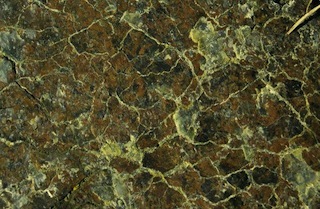The rocks of the Lizard Peninsula form one of the most interesting suite of rocks in Britain. A Pre-Cambrian age (older than 600 million years) has been assigned to them, although their exact date is difficult to pin down. The southern half of the Peninsula comprises a complex array of metamorphic and igneous rocks including serpentinite, schist, gabbro and granite, which are faulted up against Devonian slates along a boundary running roughly between Mullion Island and Nare Point. The serpentinite rock represents the remnants of part of an ancient ocean floor into which the other igneous rocks were intruded. Due to movements of the plates of rock covering the Earth’s surface, this whole complex was thrust up against continental rocks during the middle Devonian, resulting in the “welding” of the ocean floor rocks onto the continental landmass.
 |
 |
The coastal cliff exposures at Kynance Cove provide one of the best and most famous exposures of the Lizard serpentinite, and the complex array of igneous and metamorphic rocks that form it. The rocks at this site were instrumental in determining the geological history of the Lizard and provided important evidence suggesting that the rocks originally formed part of the ocean floor.
The unique geology of the Lizard peninsula, particularly serpentinite, gives rise to a similarly unique range of heathland and wetland habitats that support many rare plants and invertebrates.
Two Geological Conservation Review (GCR) sites are located within the NNR, at Kynance Cove and Kennack Sands.

Beneath The Skin of The Lizard by Robin Bates and Bill Scolding is an excellent little guide for getting to grips with the intricate story of the rocks on The Lizard.

Soils
The extreme south-west of Britain was not glaciated during the last Ice Age and so the soils largely lie over the parent rocks from which they were formed. Those lying over gabbro and serpentine-bearing rocks are ultra-basic (unusual in Britain) and there are also several deposits of loess (wind-blown glacially derived material), which is acidic in character.
Climate
The Lizard’s climate bears many similarities to that of the Mediterranean climatic zone. Almost half the annual rainfall falls between October and January, with a marked minimum from April to July. The annual daily mean temperature of over 10*C is the highest on the British mainland. Close proximity to the sea means mild winters, a low annual temperature range and a scarcity of extreme frosts.
